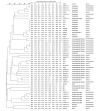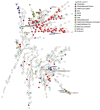High Azole Resistance in Aspergillus fumigatus Isolates from Strawberry Fields, China, 2018
- PMID: 31855142
- PMCID: PMC6924917
- DOI: 10.3201/eid2601.190885
High Azole Resistance in Aspergillus fumigatus Isolates from Strawberry Fields, China, 2018
Abstract
In 2018, we conducted a cross-sectional study to investigate azole resistance in environmental Aspergillus fumigatus isolates obtained from different agricultural fields in China. Using 63 soil cores, we cultured for azole-resistant A. fumigatus and characterized isolates by their cyp51A gene type, short tandem repeat genotype, and mating type. Of 206 A. fumigatus isolates, 21 (10.2%) were azole resistant. Nineteen of 21 had mutations in their cyp51A gene (5 TR34/L98H, 8 TR34/L98H/S297T/F495I, 6 TR46/Y121F/T289A). Eighteen were cultured from soil samples acquired from strawberry fields, suggesting this soil type is a potential hotspot for azole resistance selection. Twenty resistant isolates were mating type MAT1-1, suggesting asexual sporulation contributed to their evolution. Prochloraz, difenoconazole, and tebuconazole were the most frequently detected fungicides in soil samples with azole-resistant fungus. Our study results suggest that managing the fungicides used in agriculture will help contain the problem of antifungal drug resistance in clinics.
Keywords: Aspergillus fumigatus; China; MAT1-1; STR type; agriculture; antifungal drug resistance; antimicrobial resistance; asexual reproduction; asexual sporulation; azole fungicides; azole resistance; cyp51A; epidemiology; farms; fungi; resistance hotspot; short tandem repeat typing; strawberries; strawberry fields.
Figures


References
-
- Denning DW, Cadranel J, Beigelman-Aubry C, Ader F, Chakrabarti A, Blot S, et al.; European Society for Clinical Microbiology and Infectious Diseases and European Respiratory Society. Chronic pulmonary aspergillosis: rationale and clinical guidelines for diagnosis and management. Eur Respir J. 2016;47:45–68. 10.1183/13993003.00583-2015 - DOI - PubMed
Publication types
MeSH terms
Substances
LinkOut - more resources
Full Text Sources

